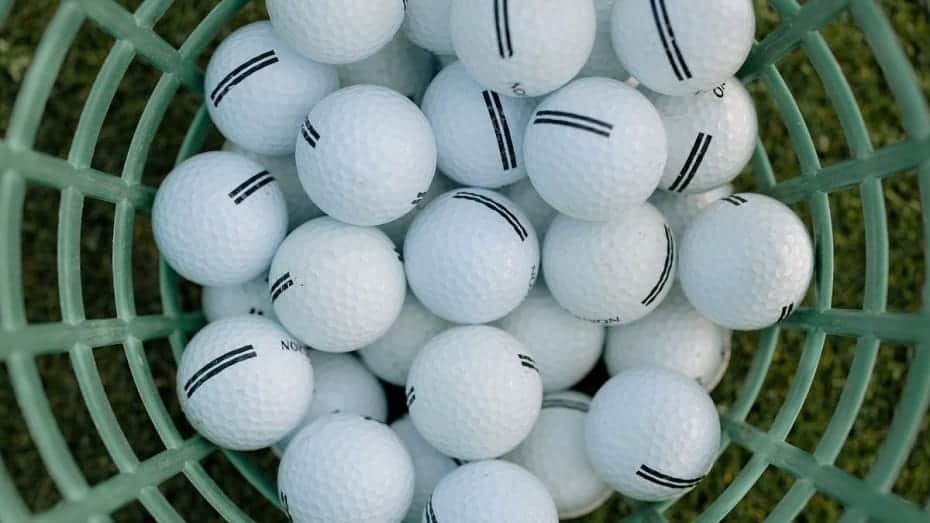As an Amazon Associate, I earn from qualifying purchases. There is no extra cost to you. Thank you if you use our links; we appreciate it! Learn More.

Are you having troubles with your golf game?
Are you looking to add more power and distance to your golf game?
Do you feel like you could be doing better if you could just compress the ball better?
If so, then you need to learn how to compress the golf ball. Compressing the golf ball is one of the most important aspects of the game and can make a big difference in your shots.
In order to compress the golf ball, you need to understand how the ball works and how you can use your body to maximize compression. The ball is designed to be hit in a certain way in order to achieve optimal results.
There are a few things you need to do in order to compress the golf ball.
- You need to have the right equipment.
- You need to have the proper technique.
- You need to hit the ball in the right spot.
In this blog post, we’ll give you a step-by-step guide on compressing the golf ball. We’ll also provide some advanced techniques and troubleshooting tips for those who want to take their game to the next level. So whether you’re a beginner or an experienced golfer, this post will have something for you.
Compressing the golf ball: the basics.
What is compression and why is it important?
Compression is an important factor in the game of golf. It can determine how far and high a golf ball will travel when hit. Compression is a measure of how tightly the core of the ball is squeezed.
The USGA (United States Golf Association) has set standards for compression. Balls with a lower compression rating will travel farther than balls with a higher compression rating. However, higher compression balls will provide more spin and better accuracy.
Knowing how to compress a golf ball is an important skill for any golfer. Follow these steps to learn how to do it correctly:
1. Select a golf ball with the compression rating that best suits your game.
2. Hold the ball in your dominant hand and place your thumb and index finger on opposite sides of the core.
3. Apply pressure to the core until it becomes firm. You should feel some resistance as you compress the ball.
4. Release your fingers and check the imprint they left on the ball. If it’s a deep impression, then the ball has a high compression rating. If the impression is light, then the ball has a low compression rating
Why you should compress the golf ball?
If you want to hit the ball farther, you need to compress the golf ball. When you compress the golf ball, it stores energy in its core. That stored energy is released when the golf ball is struck, propelling it forward with extra force. In other words, compressing the golf ball makes your shots go further!
There are a few different ways to compress a golf ball. The most common way is to use a tee. When you tee up the golf ball, the head of your club presses down on the top of the ball, compressing it slightly. You can also try hitting down on the golf ball when you make contact. This will cause the clubface to dig into the surface of the ball, compressing it even more.
Of course, there’s more to hitting a long drive than just compressing the golf ball. But if you’re looking for an extra edge, compressing the golf ball is a great place to start.
How to compress the golf ball?
There are a few things you need to know in order to compress the golf ball correctly. Here’s a step-by-step guide:
1. Place the ball on a firm surface and hold it firmly with your non-dominant hand.
2. Use your dominant hand to cup the top of the ball and press down firmly.
3. Squeeze the ball until you feel it give slightly, then release.
4. Repeat steps 2 and 3 until the ball is compressed to your desired level.
There are two main ways to compress a golf ball: using a tee, or hitting down on the ball when you make contact. Let’s take a closer look at each method:
Both methods are effective ways to increase distance.
Using a tee to compress the golf ball
This is by far the most common way to compress a golf ball. A tee can be a helpful tool for compressing the golf ball, especially if you are struggling to do so with your club alone. By placing the ball on a tee and then hitting it with your club, you can more easily compress the ball. The head of your club will press down on the top of the ball and compress it slightly as you make contact.
Read: Golf Ball Compression Vs Swing Speed
This is because the tee gives the ball a raised surface to sit on, which makes it easier to strike with enough force. Just be sure to tee the ball up high enough that it does not get in the way of your club’s swing.
Hitting down on the golf ball to compress it
One of the best ways to ensure that you are compressing the golf ball is to hit down on it slightly when you make contact. This means that your club should be descending when it hits the ball, rather than being level or ascending.
This will cause the clubface to dig in to the surface of the ball, compressing it more than if you were just using a tee.
Hitting down on the golf ball helps to reduce spin and increases distance, so it is definitely something worth trying if you are having trouble compressing the golf ball properly.
The factors that affect compression
There are three main factors that affect compression: the type of ball, the surface on which it’s being compressed, and the force applied.
The type of ball is important because it determines the amount of air inside. A harder ball, like a Pro V1, will have less air than a softer ball, like a surlyn.
The surface also matters. If you’re compressing a ball on a hard surface, it will have more compression than if you’re compressing it on a soft surface.
The force you apply is the most important factor. More force means more compression.
Measuring compression
In order to measure compression, you’ll need to use a compression gage. This is a small, handheld device that will measure the amount of pressure needed to compress the golf ball to a certain height.
There are two types of compression gages: the simple compression gage and the dynamic compression gage. The simple compression gage is less accurate but easier to use, while the dynamic compression gage is more accurate but a little more difficult to use.
Whichever type of compression gage you choose, make sure you use it in accordance with the manufacturer’s instructions.
Practice drills to improve compression
In order to improve your compression, you’ll need to practice drills that specifically target this skill. Here are a few of our favorites:
The Wall Drill
This is one of the most common drills for improving compression. Start by standing about six feet away from a wall, and then hit the ball against the wall. Make sure that you hit the ball with a downward motion, and focus on compressing the ball as much as possible.
The Alley Drill
For this drill, you’ll need two cones or markers set up in an alley formation (one at each end). Hit the ball between the cones, and make sure to compress it as much as possible.
The Mirror Drill
In this drill, you’ll be working on your compression skills while looking in a mirror. This will help you to better monitor your form and make any necessary corrections.
Once you’ve mastered these drills, you’ll be able to compress the golf ball like a pro!
Troubleshooting tips for compressing the golf ball.
My golf ball won’t compress
If your golf ball won’t compress, it could be because the ball is old or too soft. Try to find a harder ball to compress. If that doesn’t work, try using a tee to help compress the ball.
I’m compressing the golf ball but not getting the results I want
There are a few things you can try if you’re not getting the desired results from compressing the golf ball. First, make sure you’re using a hard enough ball. If that doesn’t work, try hitting down on the ball instead of just squeezing it. Finally, experiment with different clubs to see which one gives you the best results.
Conclusion…
If you want to hit the ball farther and with more accuracy, you need to learn how to compress your golf ball. This step-by-step guide will show you the basics of compressing the golf ball, as well as some advanced techniques. By following these tips, you’ll be able to improve your game and take your shots to the next level.
Amazon and the Amazon logo are trademarks of Amazon.com, Inc, or its affiliates.
Daisy is the Founder and Editor in Chief of Golfs Hub. She is associated with Golf for more than 20 years. She got the inspiration from her father. She is a very private person & doesn't like to be photographed. She's worked in nearly every job in the golf industry from club fitting to instruction to writing and speaking. Now she is enjoying her retirement from day job... but not from Golf! Daisy lives in southeasternmost part of New York state with her family.





